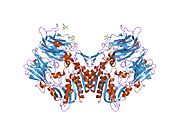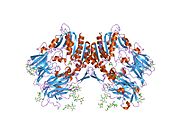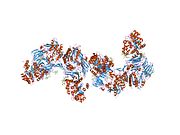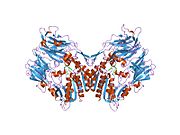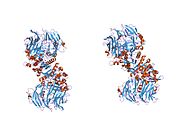Dipeptidyl peptidase-4
Dipeptidyl peptidase-4 (DPP4 or DPPIV), also known as adenosine deaminase complexing protein 2 or CD26 (cluster of differentiation 26) is a protein that, in humans, is encoded by the DPP4 gene.[5] DPP4 is related to FAP, DPP8, and DPP9. The enzyme was discovered in 1966 by Hopsu-Havu and Glenner,[6] and as a result of various studies on chemism, was called dipeptidyl peptidase IV [DP IV].
Function
[edit]The protein encoded by the DPP4 gene is an enzyme expressed on the surface of most cell types and is associated with immune regulation, signal transduction, and apoptosis. It is a type II transmembrane glycoprotein, but a soluble form, which lacks the intracellular and transmembrane part, is present in blood plasma and various body fluids. DPP-4 is a serine exopeptidase that cleaves X-proline or X-alanine dipeptides from the N-terminus of polypeptides. Peptide bonds involving the cyclic amino acid proline cannot be cleaved by the majority of proteases and an N-terminal X-proline "shields" various biopeptides.[7] Extracellular proline-specific proteases therefore play an important role in the regulation of these biopeptides.
DPP-4 is known to cleave a broad range of substrates including growth factors, chemokines, neuropeptides, and vasoactive peptides.[8][9] The cleaved substrates lose their biological activity in the majority of cases, but in the case of the chemokine RANTES and neuropeptide Y, DPP-4 mediated cleavage leads to a shift in the receptor subtype binding.[8]
DPP4 plays a major role in glucose metabolism. It is responsible for the degradation of incretins such as GLP-1.[10] Furthermore, it appears to work as a suppressor in the development of some tumors.[11][12][13][14]
DPP-4 also binds the enzyme adenosine deaminase specifically and with high affinity. The significance of this interaction has yet to be established.
Animal studies
[edit]Animal studies suggest its pathogenetic role in development of fibrosis of various organs, such as liver and kidney.[15][16]
Clinical significance
[edit]CD26/DPPIV plays an important role in tumor biology, and is useful as a marker for various cancers, with its levels either on the cell surface or in the serum increased in some neoplasms and decreased in others.[17]
A class of oral hypoglycemics called dipeptidyl peptidase-4 inhibitors works by inhibiting the action of this enzyme, thereby prolonging incretin effect in vivo.[18]
Middle East respiratory syndrome coronavirus has been found to bind to DPP4. It is found on the surface of cells in the airways (such as the lungs) and kidneys. Scientists may be able to use this to their advantage by blocking the virus's entry into the cell.[19]
DPP4,[20] or its Mycobacterial homologue MtDPP,[21] might play a role in the pathogenesis of tuberculosis via cleavage of the chemokine C-X-C motif chemokine ligand 10 (CXCL10).
See also
[edit]References
[edit]- ^ a b c GRCh38: Ensembl release 89: ENSG00000197635 – Ensembl, May 2017
- ^ a b c GRCm38: Ensembl release 89: ENSMUSG00000035000 – Ensembl, May 2017
- ^ "Human PubMed Reference:". National Center for Biotechnology Information, U.S. National Library of Medicine.
- ^ "Mouse PubMed Reference:". National Center for Biotechnology Information, U.S. National Library of Medicine.
- ^ Kameoka J, Tanaka T, Nojima Y, Schlossman SF, Morimoto C (July 1993). "Direct association of adenosine deaminase with a T cell activation antigen, CD26". Science. 261 (5120): 466–9. Bibcode:1993Sci...261..466K. doi:10.1126/science.8101391. PMID 8101391.
- ^ Hopsu-Havu VK, Glenner GG (1966). "A new dipeptide naphthylamidase hydrolyzing glycyl-prolyl-beta-naphthylamide". Histochemie. Histochemistry. Histochimie. 7 (3): 197–201. doi:10.1007/bf00577838. PMID 5959122. S2CID 9674831.
- ^ Vanhoof G, Goossens F, De Meester I, Hendriks D, Scharpé S (June 1995). "Proline motifs in peptides and their biological processing". FASEB Journal. 9 (9): 736–44. doi:10.1096/fasebj.9.9.7601338. PMID 7601338. S2CID 37551773.
- ^ a b Mentlein R (November 1999). "Dipeptidyl-peptidase IV (CD26)--role in the inactivation of regulatory peptides". Regulatory Peptides. 85 (1): 9–24. doi:10.1016/S0167-0115(99)00089-0. PMID 10588446. S2CID 22354304.
- ^ Chen X (2006). "Biochemical properties of recombinant prolyl dipeptidases DPP-IV and DPP8". Dipeptidyl Aminopeptidases. Advances in Experimental Medicine and Biology. Vol. 575. pp. 27–32. doi:10.1007/0-387-32824-6_3. ISBN 978-0-387-29058-4. PMID 16700505.
- ^ Barnett A (November 2006). "DPP-4 inhibitors and their potential role in the management of type 2 diabetes". International Journal of Clinical Practice. 60 (11): 1454–70. doi:10.1111/j.1742-1241.2006.01178.x. PMID 17073841. S2CID 2645092.
- ^ Pro B, Dang NH (October 2004). "CD26/dipeptidyl peptidase IV and its role in cancer". Histology and Histopathology. 19 (4): 1345–51. doi:10.14670/HH-19.1345. PMID 15375776.
- ^ Masur K, Schwartz F, Entschladen F, Niggemann B, Zaenker KS (December 2006). "DPPIV inhibitors extend GLP-2 mediated tumour promoting effects on intestinal cancer cells". Regulatory Peptides. 137 (3): 147–55. doi:10.1016/j.regpep.2006.07.003. PMID 16908079. S2CID 2857735.
- ^ Wesley UV, McGroarty M, Homoyouni A (February 2005). "Dipeptidyl peptidase inhibits malignant phenotype of prostate cancer cells by blocking basic fibroblast growth factor signaling pathway". Cancer Research. 65 (4): 1325–34. doi:10.1158/0008-5472.CAN-04-1852. PMID 15735018.
- ^ Busek P, Malík R, Sedo A (March 2004). "Dipeptidyl peptidase IV activity and/or structure homologues (DASH) and their substrates in cancer". The International Journal of Biochemistry & Cell Biology. 36 (3): 408–21. doi:10.1016/S1357-2725(03)00262-0. PMID 14687920.
- ^ Kaji K, Yoshiji H, Ikenaka Y, Noguchi R, Aihara Y, Douhara A, Moriya K, Kawaratani H, Shirai Y, Yoshii J, Yanase K, Kitade M, Namisaki T, Fukui H (March 2014). "Dipeptidyl peptidase-4 inhibitor attenuates hepatic fibrosis via suppression of activated hepatic stellate cell in rats". Journal of Gastroenterology. 49 (3): 481–91. doi:10.1007/s00535-013-0783-4. PMID 23475323. S2CID 2726091.
- ^ Min HS, Kim JE, Lee MH, Song HK, Kang YS, Lee MJ, Lee JE, Kim HW, Cha JJ, Chung YY, Hyun YY, Han JY, Cha DR (June 2014). "Dipeptidyl peptidase IV inhibitor protects against renal interstitial fibrosis in a mouse model of ureteral obstruction". Laboratory Investigation; A Journal of Technical Methods and Pathology. 94 (6): 598–607. doi:10.1038/labinvest.2014.50. PMID 24687121. S2CID 23745972.
- ^ Havre PA, Abe M, Urasaki Y, Ohnuma K, Morimoto C, Dang NH (January 2008). "The role of CD26/dipeptidyl peptidase IV in cancer". Frontiers in Bioscience. 13 (13): 1634–45. doi:10.2741/2787. PMID 17981655.
- ^ Rosenstock J, Zinman B (April 2007). "Dipeptidyl peptidase-4 inhibitors and the management of type 2 diabetes mellitus". Current Opinion in Endocrinology, Diabetes and Obesity. 14 (2): 98–107. doi:10.1097/MED.0b013e3280a02f65. PMID 17940427. S2CID 25482131.
- ^ Raj VS, Mou H, Smits SL, Dekkers DH, Müller MA, Dijkman R, Muth D, Demmers JA, Zaki A, Fouchier RA, Thiel V, Drosten C, Rottier PJ, Osterhaus AD, Bosch BJ, Haagmans BL (March 2013). "Dipeptidyl peptidase 4 is a functional receptor for the emerging human coronavirus-EMC". Nature. 495 (7440): 251–4. Bibcode:2013Natur.495..251R. doi:10.1038/nature12005. PMC 7095326. PMID 23486063.
- Tina Hesman Saey (March 13, 2013). "News in Brief: New virus uses protein handle to infect cells". ScienceNews. Archived from the original on 2013-03-20.
- ^ Blauenfeldt T, Petrone L, Del Nonno F, Baiocchini A, Falasca L, Chiacchio T, Bondet V, Vanini V, Palmieri F, Galluccio G, Casrouge A, Eugen-Olsen J, Albert ML, Goletti D, Duffy D, Ruhwald M (Jul 2018). "Interplay of DDP4 and IP-10 as a Potential Mechanism for Cell Recruitment to Tuberculosis Lesions". Front Immunol. 9 (1456): 1456. doi:10.3389/fimmu.2018.01456. PMC 6041415. PMID 30026741.
- ^ Lioe TS, Xie Z, Wu J, Li W, Sun L, Feng Q, Raju S, Tefsen B, Ruiz-Carrillo D (Jan 2023). "The Mycobacterium tuberculosis prolyl dipeptidyl peptidase cleaves the N-terminal peptide of the immunoprotein CXCL-10". Biol Chem. 404 (6): 633–43. doi:10.1515/hsz-2022-0265. PMID 36632703. S2CID 255596512.
Further reading
[edit]- Ansorge S, Bühling F, Kähne T, Lendeckel U, Reinhold D, Täger M, Wrenger S (1997). "CD26/Dipeptidyl Peptidase IV in Lymphocyte Growth Regulation". Cellular Peptidases in Immune Functions and Diseases. Advances in Experimental Medicine and Biology. Vol. 421. pp. 127–40. doi:10.1007/978-1-4757-9613-1_17. ISBN 978-1-4757-9615-5. PMID 9330689.
- Reinhold D, Kähne T, Steinbrecher A, Wrenger S, Neubert K, Ansorge S, Brocke S (2003). "The role of dipeptidyl peptidase IV (DP IV) enzymatic activity in T cell activation and autoimmunity". Biological Chemistry. 383 (7–8): 1133–8. doi:10.1515/BC.2002.123. PMID 12437097. S2CID 30027839.
- Sato K, Dang NH (March 2003). "CD26: a novel treatment target for T-cell lymphoid malignancies? (Review)". International Journal of Oncology. 22 (3): 481–97. doi:10.3892/ijo.22.3.481 (inactive 1 November 2024). PMID 12579300.
{{cite journal}}: CS1 maint: DOI inactive as of November 2024 (link) - de Meester I, Lambeir AM, Proost P, Scharpé S (2003). "Dipeptidyl Peptidase IV Substrates". Dipeptidyl Aminopeptidases in Health and Disease. Advances in Experimental Medicine and Biology. Vol. 524. pp. 3–17. doi:10.1007/0-306-47920-6_1. ISBN 0-306-47717-3. PMID 12675218.
- Koch S, Anthonsen D, Skovbjerg H, Sjöström H (2003). "On the role of dipeptidyl peptidase IV in the digestion of an immunodominant epitope in celiac disease". Dipeptidyl Aminopeptidases in Health and Disease. Advances in Experimental Medicine and Biology. Vol. 524. pp. 181–7. doi:10.1007/0-306-47920-6_22. ISBN 0-306-47717-3. PMID 12675238.
- Pro B, Dang NH (October 2004). "CD26/dipeptidyl peptidase IV and its role in cancer". Histology and Histopathology. 19 (4): 1345–51. doi:10.14670/HH-19.1345. PMID 15375776.
External links
[edit]- The MEROPS online database for peptidases and their inhibitors: S09.003
- Dipeptidyl-Peptidase+IV at the U.S. National Library of Medicine Medical Subject Headings (MeSH)
- Banting and Best Diabetes Centre at UT dpp4











